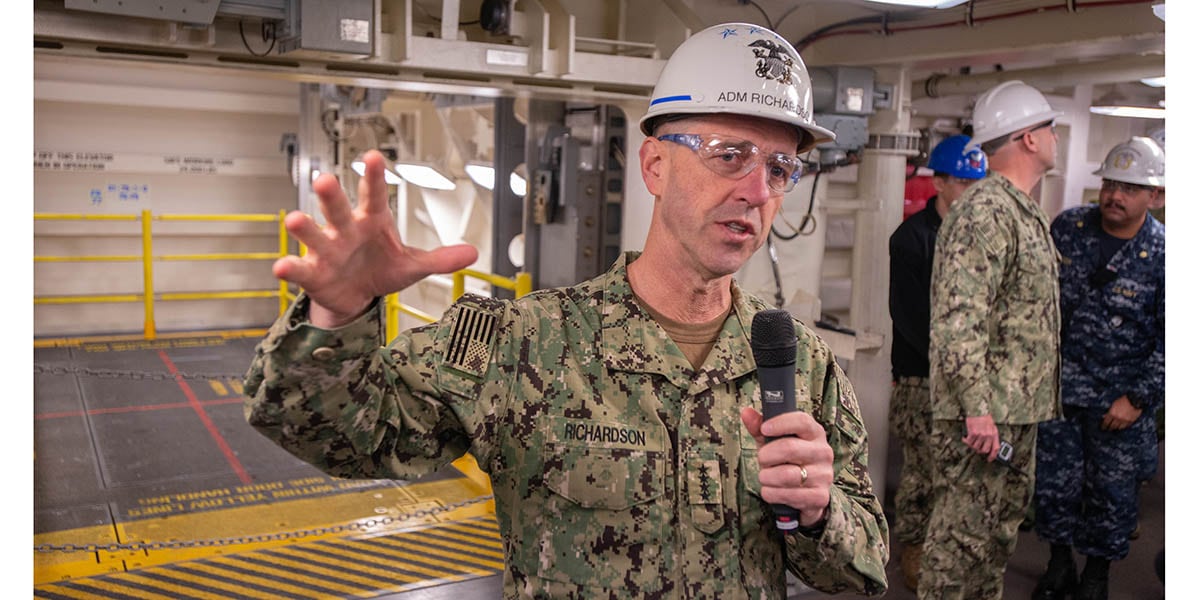NEWPORT NEWS, Va. — Seven months into the aircraft carrier Gerald R. Ford’s yearlong stay at Huntington Ingalls Shipyard here, the flattop has received its second Advanced Weapons Elevators, a critical component for moving ordnance to the flight deck and hiking the rate of fighter sorties.
Two down and nine more to go, with Pentagon officials still predicting that all of the elevators will be running by the time the flattop leaves the yard this summer.
“Working on USS Gerald R. Ford’s advanced weapons elevators has been the most amazing experience since reporting here in 2013,” said Machinist’s Mate 2nd Class Shameka Judene, a Georgia native who’s spent six of her nine years in the Navy helping to build the Ford.
“To be able to watch the elevators transform from a shell into the most technologically advanced weapons elevators is something to marvel. It’s been a truly rewarding experience.”
Sailors weren’t always so optimistic about the Ford.
Loaded with high technology, the first in its class of flattops came with a big price tag — $13 billion — and critics wondering whether it would ever meet its promised operating capability due to snafus with the Ford’s innovative electronic catapult, arresting gear and elevators.
Once its fully outfitted, however, designers expect the Ford to generate up to to 25 percent more combat sorties than Nimitz-class carriers can handle, a potentially crucial edge over enemy fleets.
RELATED

And that’s why the yard and the flattop’s crew has worked so hard to get the elevators humming. The lifts are expected to ferry 24,000 pounds of ordnance at a rate of 150 feet per minute from the ship’s magazines to the flight decks.
Using hydraulic cable and pulleys, Nimitz-class elevators top out at 10,500 pounds and move weapons at only 100 feet per minute.
“All of us are learning on brand new systems and brand new concepts," said Cmdr. Joe Thompson, the Ford’s weapons officer.
"This acceptance gives us the opportunity to have that ‘run time’ on the physical aspects of the elevator, but also in evaluating the technical manuals, and learning the maintenance required to keep them operational.”
Doubling the number of elevators doubled the amount of training the Weapons Department crew can do.
“This is going to allow us to progress faster,” Thompson said. “As we get smarter on one, we move on to the next and apply the lessons learned not only with regard to elevator operation, but also in the testing and certification and maintenance processes.”
RELATED

Accepted in January, Elevator 1 totes ordnance from the ship’s forward weapons handling area up to the flight deck. Upper Stage 3, the new lift, is located in the carrier’s aft weapons handling area.
Once fully installed, the Ford’s system will eliminate the need for a Nimitz-class carrier’s “bomb farm,” where weapons are staged on mess decks and in the hangar bay.
“From a weapons safety perspective, this is a huge advantage,” Thompson said. “We have two dedicated locations that are not on the flight deck or in the hangar bay that have 24-7 overhead sprinkler coverage and the ability to jettison in the case of an emergency.
"To have these locations that allows us to operate without interfering with flight operations or in the hangar bay makes our ship that much safer.”
The Ford’s skipper, Capt. John J. Cummings, said the combined crew of shipyard and Navy personnel working to certify the new elevators already have shaved 10 days off scheduled delivery of the elevators and he expects the fast rate to continue.
“These are the most technologically unique elevators in the world, and we are going to need to find innovative methods to get the remaining nine elevators delivered this year," Cummings said. “Our Weapons Department sailors are hungry to operate these elevators so we can start developing procedures to maximize the flow of ordnance from our magazines to the flight deck."
Mark D. Faram is a former reporter for Navy Times. He was a senior writer covering personnel, cultural and historical issues. A nine-year active duty Navy veteran, Faram served from 1978 to 1987 as a Navy Diver and photographer.





